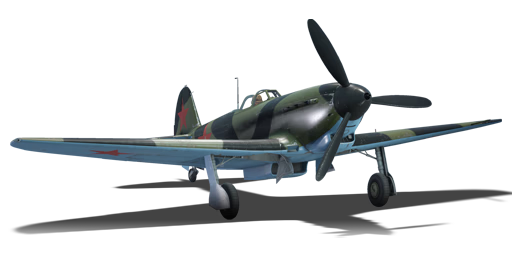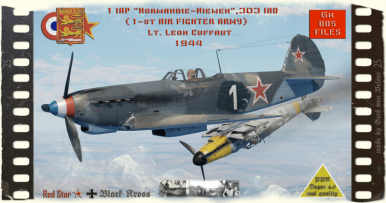



The Yakovlev Yak-9T was the second variant of the Yak-9 fighter aircraft family. Instead of the usual 20 mm ShVAK cannon, it was armed with a 37 mm Nudelman-Suranov NS-37 cannon with 30 rounds. To compensate for the heavier nose, the cockpit was shifted backwards by 0.4 m. Poor quality control resulted in many oil and coolant leaks from the cannon recoil during test firing, which were solved during the prototype testing stage. Recoil and limited ammunition availability necessitated precise aiming with two- or three-round bursts. The Yak-9T was widely used against enemy ships on the Black Sea and tanks on various fronts (the cannon could penetrate up to 40 mm armour from 500 m), but it was also effective against enemy aircraft (a single cannon hit was usually enough to tear apart the aircraft airframe). Yak-9T had a significant morale impact on the opponent. It was extremely popular among flight crews, owing to its formidable weaponry and excellent flight performance. The aircraft was mass-manufactured from March 1943 to June 1945, and a total of 2,748 aircraft were produced. Flight experiments were carried out on the Central Front in August 1943 by the 16VA ("Vozdushnaya Armia" - Air Army).
Introduced in the Open Beta Test prior to Update 1.27, the Yak-9T is an anti-tank variant with a 37 mm Nudelman-Suranov NS-37 gun capable of firing armour-piercing ammunition that can readily penetrate tank roof armour while diving. Since the ammo capacity is limited to 30 rounds due to the increased weight of the weapon, precise aiming is essential. It is advisable to fire only in short bursts, as continuous firing reduces accuracy and quickly overheats the cannon barrel. This, paired with the Yak-9 fighter aircraft family's superb low-altitude performance, will undoubtedly make the Yak-9T an excellent close-air support plane in the hands of an experienced player.
flaps
flaps
flaps
brake
| Belt | Belt filling | Armor penetration (mm) at a distance: | |||||
|---|---|---|---|---|---|---|---|
| 10 m | 100 m | 500 m | 1000 m | 1500 m | 2000 m | ||
| AP-T/HEI-T | 71 | 68 | 57 | 46 | 37 | 30 | |
| HEI-T | 9 | 8 | 7 | 6 | 5 | 5 | |
| AP-T | 71 | 68 | 57 | 46 | 37 | 30 | |
| Belt | Belt filling | Armor penetration (mm) at a distance: | |||||
|---|---|---|---|---|---|---|---|
| 10 m | 100 m | 500 m | 1000 m | 1500 m | 2000 m | ||
| T/AP/AP/IAI | 32 | 30 | 22 | 15 | 11 | 7 | |
| AP-I/API-T/IAI/IAI | 29 | 27 | 20 | 13 | 9 | 6 | |
| API-T/AP-I/AP-I/IAI | 29 | 27 | 20 | 13 | 9 | 6 | |
| AP-I(c)/AP-I/AP-I/API-T/IAI | 34 | 32 | 24 | 17 | 12 | 8 | |
| API-T | 29 | 27 | 20 | 13 | 9 | 6 | |
| AP-I/AP-I/IAI | 29 | 27 | 20 | 14 | 9 | 6 | |












Flight performance | |
|---|---|
Survivability |
|---|
Weaponry |
|---|
